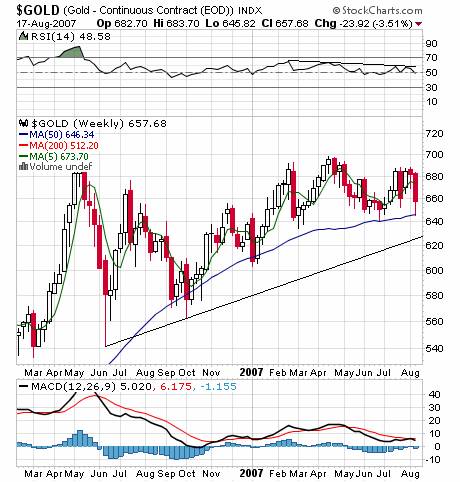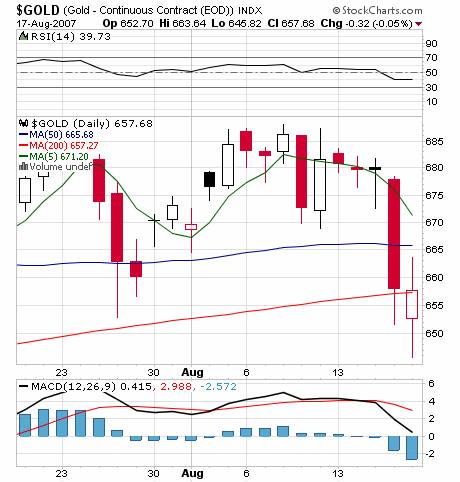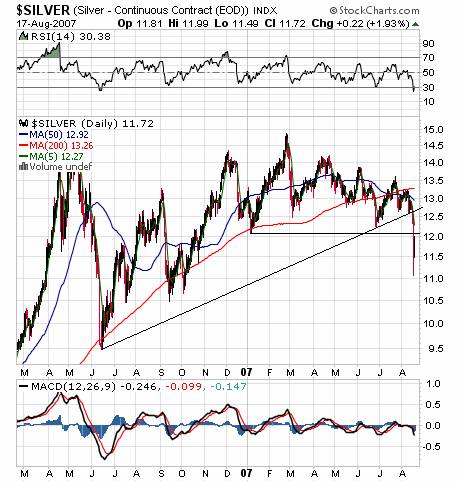Gold and Silver Analysis - Precious Points: Gold Got Sold, but Should You Hold?
Commodities / Gold & Silver Aug 18, 2007 - 07:32 PM GMTBy: Joe_Nicholson
 It's not at all likely that the credit crunch which plagued the markets last week will be resolved when trading on Monday resumes. But … it appears the Fed is sensitive to the market and will continue providing liquidity as needed, virtually on demand. The pace at which … the Fed is able to remove the billions of new dollars from the money supply, if at all, will largely determine the direction for metals in the coming weeks. All that is reasonably certain is that if the liquidity situation only deteriorates from here, which would probably have to occur before a rate cut is truly on the table, precious metals, along with most assets, will suffer in the short run. ~ Precious Points: Bernanke the Maestro , August 11, 2007
It's not at all likely that the credit crunch which plagued the markets last week will be resolved when trading on Monday resumes. But … it appears the Fed is sensitive to the market and will continue providing liquidity as needed, virtually on demand. The pace at which … the Fed is able to remove the billions of new dollars from the money supply, if at all, will largely determine the direction for metals in the coming weeks. All that is reasonably certain is that if the liquidity situation only deteriorates from here, which would probably have to occur before a rate cut is truly on the table, precious metals, along with most assets, will suffer in the short run. ~ Precious Points: Bernanke the Maestro , August 11, 2007
Financial market conditions did deteriorate further this week and, as expected, the metals did suffer. Readers of this update will have long abandoned the notion that gold or silver would receive flight to quality benefits in a liquidity crunch. To the contrary, metals are an excellent source of liquidity, particularly when so many hedge funds hold substantial profits in their ETF holdings, and naturally these were sold to accommodate the funding needs of a rapidly unwinding carry trade, imploding corporate debt market, and investor redemptions.

The good news, as shown in the chart above, is that gold perfectly held the 50-week moving average long watched here as strong, critical support. The RSI downtrend did prove problematic, but has not moved back to levels that could support a rally. However, despite the Fed announcement on Friday and weakness in the dollar, gold failed at the 50-day moving average as shown in the chart below, a level also monitored recently, and resistance in the 665/70 area will be crucial to any recovery next week, as will the 200-day moving average, where gold limped into the close.

Silver, after it's recent underperformance and perilous position at last weekend, was predictably hit hard this week and broke through major support. Though it recovered after free-falling on Thursday down to $11, the technical damage is now considerable and the possibility of a plunge below $10 cannot be ignored. Fundamental analysis would posit this is a dislocation created by the chaotic condition of all markets lately, but nonetheless, without a serious catalyst, silver could now be mired in a lower trading range for the near term. Certainly the Fed's relatively disciplined use of its power to create liquidity now forces the rethinking of everything from the future of the money supply, the global economic boom, and the precious metals bull market. At the very least, silver will likely face considerable resistance before new highs can even be contemplated.

But this is not to say the long term prospects for precious metals as a whole are as yet anything less than optimistic. Short term pressure during a credit crisis is absolutely to be expected, but to the extent it appears the Fed will remain committed to a policy of sustained, if controlled, inflation, the ultimate recovery of the financial markets alone virtually guarantees future upside in the metals.
The fact that the decision to cut the discount rate was initially on the recommendation of and only in effect for two of the Federal Reserve districts (New York and San Francisco, which governs the west coast region where Countrywide Bank is centered), underscores the emergence of Bernanke as the calm and capable leader of the Fed described here last week in a piece titled Bernanke the Maestro . After Bernanke's before-the-bell cut in the discount rate, the man has to be taken seriously – respected at least, if not feared – and his tenacious will to preserve economic growth is a key factor.
With the Fed the subject of so much limelight over the past few weeks, it's probably important to remember that it is and has always been an independently owned private entity with a charter giving it exclusive power to regulate the U.S. banking system and money supply. Certainly no one long puts or short calls Friday morning questions the Fed's substantial power any longer. Speculation is rampant now about what the change in Fed policy means about the future, but in taking a series of steps easily understood in light of policy statements and speeches, it seems Bernanke has been extraordinarily transparent.
The July statement clearly expressed a disinclination to cut the target rate, a fact mentioned here repeatedly and thus far a guiding principal in the Fed's actions to date. The rate targeting policy itself suggested the Fed would be ready to inject liquidity if necessary and, though there was speculation at the time that the injections were tantamount to a “stealth hike”, nothing could be further from the truth. Even the discount rate, which was finally lowered on Friday morning, would not have been cut if not for a further disintegration in the credit markets, which did appear most notably as a freeze in the corporate paper markets and the start of a “run” on Countrywide Bank. In response, the Fed has lowered its lending rate on lower quality collateral not to crush traders shorting an already damaged market, but to allow Countrywide, a bank, to remain solvent and avoid sparking a pandemic of withdrawals … countrywide.
But the lower penalty at the discount window is not itself a sign of a pending cut in the target cut! Certainly it is an intermediate step that probably needs to occur before the Fed will finally capitulate and cut, but there is no direct correlation. In other words, a cut in the target rate is still, and remains, dependent on economic growth, not liquidity in the financial markets. To wit, today's statement leaves the change in the discount rate open-ended, “until the Federal Reserve determines that market liquidity has improved materially.” Given the Friday statement and Fed's ability to create substantial new money from its relatively modest balance sheet, it's reasonable to expect the Fed will not lower rates any further unless it is compelled to do so, as it was on Friday by a legitimate calamity the likes of which would have probably even led Poole to favor a cut, were he available to express his opinion. In fact, the Fed would probably be just as willing, if not more, to re-raise the discount rate as cut the target rate to reestablish its 100 basis point penalty.
The fate of gold, then, as well as of stocks and all other asset classes, continues to depend on the resolution of these liquidity issues. Very significantly, the Fed has been working behind the scenes meeting with major banking firms and encouraging use of the discount window, which for decades has been treated as a last resort reserved for the dead and dying. The implication is also that the Fed is likely working actively with government agencies and foreign central banks to coordinate actions that will preserve the strong global growth trend as it shepherds domestic growth through this decidedly difficult period. But, the coming weeks could also bring to light the full extent of the damage, including as yet untold disasters in a decline that is expected to be measured in months or years, any one of which could trigger another round of heavy liquidation.
Remember, the Fed's rate-targeting regime promises new money on demand whether it's for crisis or growth. Short of a complete annihilation of the financial markets as we know them, only the latter suggests further gains for precious metals, and this is still the outcome Bernanke seems to favor strongly. But, in as much as he's made a clean break from the hyperinflationary tendencies of his predecessor, another parabolic run as in 2006 is increasingly less likely unless fundamentals force the issue, a topic which will have to be addressed later in the year. Still, metals should reasonably make up at least 10% of any diversified portfolio, and gold's positive showing at the 50-week moving average, again, not only continues to provide an excellent entry point, it suggests this is one asset worth holding for the long haul.
by Joe Nicholson (oroborean)
This update is provided as general information and is not an investment recommendation. TTC accepts no liability whatsoever for any losses resulting from action taken based on the contents of its charts,, commentaries, or price data. Securities and commodities markets involve inherent risk and not all positions are suitable for each individual. Check with your licensed financial advisor or broker prior to taking any action.
Joe Nicholson Archive |
© 2005-2022 http://www.MarketOracle.co.uk - The Market Oracle is a FREE Daily Financial Markets Analysis & Forecasting online publication.


